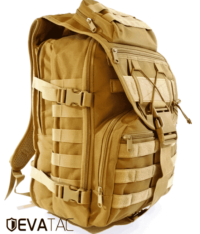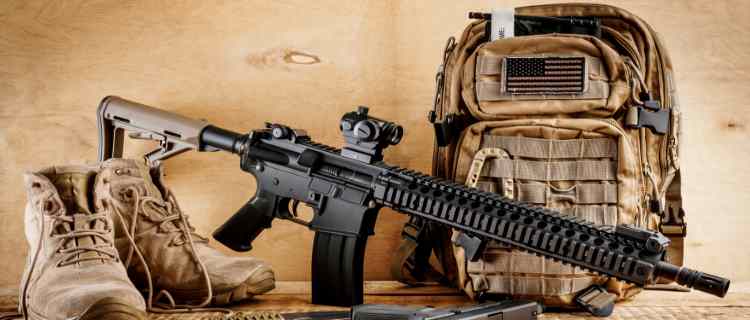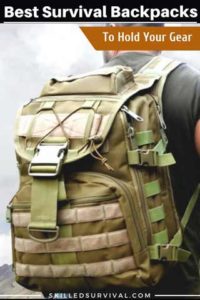
Because what’s the ONLY way to ensure access to survival tools? Carrying a survival backpack. Mine allows me to carry all my emergency gear everywhere I go. But with so much riding on your pack, it would be a shame to rely on cheap one…
Sorry Jan Sport, your bags are wimpy… If the pack you choose can’t hold up to abuse, you’re risking it all!
TOPICS IN THIS GUIDE… ↓(click to jump)
- Best Survival Backpacks Today
- Best Survival Backpack Features
- How Size Properly Size One
- The Survival Gear Worth Packing
Best Emergency Backpacks For Sale Today
Here are a few of the best ones available on the market today:
This tactical EDC backpack is as tough as they come at a fantastic price point.
It has heavy-duty zippers, padded shoulder straps, a chest strap, and enough compartments to keep all your survival gear properly organized.
This bag includes a 40L storage capacity. Making it the perfect bag for those who have a lot of gear to haul around.
It’s made from thick, durable 600D Polyester.
It comes with heavy-duty clips. Because a bag is only as good as its clips.
It has padded shoulder straps and a padded back panel for maximum comfort. Because a comfortable bag is essential, especially for daily use.
It has a quick lock chest strap securing the bag even while on the run or scrambling. This helps to prevent the bag from bouncing while on the move!
All compartments are waterproof. This is a must-have feature for high-quality tactical bag.
It includes a total of 10 separate carry compartments. This allows for maximum organization!
Heck, it even has a dedicated padded laptop compartment. This helps protect your fragile items from bumps and knocks.
Similar bags with all these features sell for over $159 (some as much as $229 in many outdoor specialty stores).
But you can get The Combat Bag From EVATAC at a fraction of those insane prices. Click here to see if this fantastic deal is still available.
↓ The Combat Bag by EVATAC
The EVERLIT pack takes all the guesswork off your hands.
Instead of getting the bag, and then the gear.
Just get it all in one simple purchase.
The bag and the gear were hand-picked by veterans and field tested by survivalists.
This Camping Emergency Kit has more than 23 unique accessories, survival tools, gadgets, camping gear, and first aid supplies.
All packed into a 900D fabric 42L tactical backpack.
↓ EVERLIT Tactical Backpack
The Rush72 is a large tactical pack with insanely high reviews.
It comes in a variety of different colors and includes:
- dual-zippered compartments with YKK zippers
- an organization pouch for pens, maps, or documents
- hydration pack compatible
- an extensive MOLLE system
It's an excellent tactical backpack, but you must pay a bit more for it...
↓ 511 Rush 24 Back Pack
The Condor 3-Day pack is a bit more complex and priced accordingly.
It’s a solid, well-built pack with a large main compartment.
That single large compartment can be a little floppy and shapeless if it's not full.
But you can manage that with the compression straps.
The internal straps help keep gear in place while on the move.
The MOLLE webbing allows you to add anything you want to the exterior panels.
↓ Condor 3-Day Assault Pack
Reebow Gear wants to bring fans of military gear the best equipment possible.
All their gear is a standard of high-performance military and tactical gear.
This camouflaged pack comes in black camo or woodland camo colors.
It's a 34-liter pack made of high-density, water-resistant nylon fabric.
It includes:
- side and front-load compression system
- a Molle system, ventilated mesh shoulder strap padding
- a compartment for a hydration pack
You can get this tactical pack at a budget-friendly price point.
↓ Reebow Tactical Backpack
Best Survival Backpack Features
There IS such a thing as TOO many choices. It’s called Analysis Paralysis… And what’s worse is most look the same. So how can you tell if one is quality or not?
Sure, there’s an occasional attempt at a unique feature here and there. But for the most part, they’re carbon copies. And when someone comes out with a “unique feature,” how can you know it’s not hype? How can you tell if it’s worth the extra money?
The bottom line is: Sorting through all the survival packs is a daunting task. You need a way to filter down your options – FAST. That’s why I recommend starting with key features.
Does Size Matter? Yes.
The most crucial aspect is size. I’m not talking about how it fits (we’ll get to that later) but rather how much stuff it can hold. Because:
“The difference between “want” and “need” is how far your willing to haul it on your back” – “Just In Case” Jack
Packs are measured in volume, with cubic inches or liters. This number allows us to compare survival packs. And determines how much gear they should hold.
However, they measure this by filling every pocket of the pack with small plastic beads. Stuffing every nook and every cranny. They do this until the whole thing looks like an overstuffed beanbag. Then they dump all the beads into a container.
They then measure the total volume of the pack. All without having to measure the internal spaces of each pocket individually. Of course, your gear doesn’t pack as tightly as those beads. However, it’s worth the time to reduce empty space as much as possible.
To keep your overall load compact and efficient. And while your first impulse is to get the biggest pack you can find, that’s a terrible idea! Even if a giant pack allows you to add every tool known to man, YOU HAVE TO CARRY IT.
Unless you can afford to hire a golf caddy. Otherwise, YOU’RE the mule. How far can you walk with a 100 lbs. pack on your shoulders?
Instead, what if you cut down your gear to the bare essentials? I’ve found that the 30-40 liter range is about the perfect size for me. No, that’s not massive, but it’s light and comfortable! So I’m very deliberate about what goes into my pack.
You see, the problem with heavy packs is they suck to haul around. So naturally, after about 2 weeks of wearing it daily, you decided to take a day off. You’re only going to leave it at home “just this once”…
Then you realize how nice the break is and take another day off. Then one day, you realize you haven’t worn your pack for 6 months! But, with my lighter survival backpack, I can hike all day through rugged terrain and still have plenty left in the tank.
I can also squeeze through small passages without on branches and rocks. That kind of maneuverability is important. Especially if you’re trying to save time and save energy – or when you’re in fight or flight mode.
So do yourself (and your back) a favor – keep it reasonable, nibble, and light.
Comfort Starts and Ends With Padding
When I hear the word “comfort,” I cringe. I can’t help it. Being a self-reliant human is the exact opposite of “extreme comfort.”
Being resilient is all about intentional challenge and purpose. But today, I’m not talking about obscene societal comforts and luxuries – such as day spas, conditioned air, and motorized sofas.
When it comes to wearing a backpack, comfort should rank high on the list. Why? Because if it fits properly and comfortably, it will reduce discomfort. That way, you’ll be more focused on the task at hand.
Pack comfort increases endurance and speed by avoiding frequent stops. So in this instance, comfort is a tactical advantage.
Padded Shoulder Straps
Get a pack with well-built and generously padded shoulder straps. Your shoulders are the main point of contact between your body and the pack. So they’re pretty important.
If you ignored my advice about size and weight – and your backpack weighs over 40 lbs. – make sure you get a pack with hip straps. That way, most of the weight will ride on the hip belt. These hip straps transfer the load directly to your legs. But that’s only for heavier packs.
For lighter backpacks, a good set of padded shoulder straps is more than enough. Just make sure the shoulder straps have good risers.
Risers
Risers, you ask? That’s just cool-kid lingo used by pack manufacturers. Risers are the adjustment straps above your shoulder. They help to keep the pack snug and close to your back for better balance.
Sternum Strap
An adjustable sternum strap across your chest is also a nice comfort bonus. This prevents the shoulder straps from sliding out and pulling back on your arms.
For women, contoured shoulder straps can be more comfortable. Women often need a bit more space around their chest area. They’re harder to find, but sometimes you can swap the straps from another pack.
Throw It Down A Cliff, And It Survives Cuz It’s Tough As Hell
All design features are pointless if the pack falls apart at the seams. You want:
- High-strength webbing straps
- Heavy-duty zippers
- Abrasion-resistant materials
- Double stitching in key locations
YKK “self-healing” zippers are an industry-leading standard. I’ve never had one blowout for over 30 years.
↓ YKK AquaGuard Zipper
Cordura and ripstop nylon are great choices as well. While I love lightweight silicone-coated nylon. This isn’t the proper application. It has lower resistance to abrasion, punctures, and tears – not good enough for survival.
Waterproof survival backpacks are nice. But I’ve never seen a pack that didn’t leak. I’d rather save the money on “waterproof” and invest it elsewhere in my kit. Using a heavy-duty trash bag as a waterproof liner is far more cost-effective.
You can also swap in a new trash bag liner if yours ever leaks.
Quick Retrieval Systems (a.k.a. small exterior pockets)
There might be more unique pack pocket layouts than there are manhole covers in New York. Recently, it’s been like an arms race between manufacturers. It seems like the one who can add more special pockets than anyone else wins.
Sure, I appreciate additional organization – but to a point. It’s getting out of hand.
Remember, each additional pocket requires more material and more zippers. This adds up to more weight.
Unnecessary pack weight is bad – ask your back – it agrees!
So instead of a pack with 30 different pockets, look for one with:
- 1-2 main compartments for clothes, freeze-dried food, and camping gear (tent, sleeping bag, etc.)
- a few medium pockets for things you “might” need during the day while hiking
- a couple of small pockets for those easy-to-lose items
I’m a fan of a few strategically placed small pockets. Either directly on the hip belt, on the shoulder straps, or near the top of the pack. These provide a place to stash small items while on the move.
Yet keep you from taking the pack off to get to them.
A lighter, a knife, some sunscreen, snacks, a compass, and a topo map live in the small exterior pockets. If you carry a gun, stash a few rounds of extra ammo in an exterior pocket for quick, easy access.
You can’t afford to root around the bottom of your pack to reload mid-combat!
MOLLE and other exterior mounting systems have a place here as well. They provide easy attachment points for all kinds of items. They allow you to expand your carry capacity and customize your pack.
↓ Everything You Need To Know About MOLLE
However, keep in mind – exterior items are easy for others to see. So you might want to keep your loaded pistol in a concealed pouch.
Also, exterior items tend to catch on branches and other obstacles and are easy to lose if knocked loose.
Thirst-Quenching On The Go? – Yes, Please

Hydration System
A hydration system can be a huge timesaver while on the move. Most can carry 2-4L of water in a flexible plastic bladder. You drink from the bladder via a hose, eliminating the need to carry a separate water bottle.
Place the bladder in the pack’s center, right against your back. This provides the best load distribution and balance. Of course, be sure to keep any sharp objects away from the bladder. If you pop a hole in it, you may not know about it until it’s too late.
Like when you eventually feel the water dripping out the bottom of your pack and soaking everything inside.
One cautionary note – water bladders are plastic, so you can’t boil water in one. So you might want to stash a small single-walled stainless steel water bottle if you’re forced to boil water to purify it.
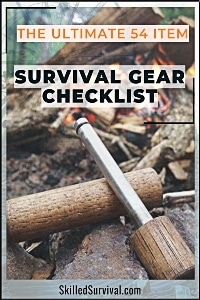
Want a free 54 item survival gear checklist?
Enter your email below to instantly download this Complete Checklist PDF. No purchase necessary. 👇 👇How To Choose The Perfect Size
Like clothing, packs come in many sizes to fit many different body types – from small to XX large. Picking the correct size is crucial to ensuring the pack fits properly and is comfortable with a load.
Pack sizes are determined by torso length. A measurement of the distance from the base of your neck to the small of your back. Have someone use a flexible measuring tape. Start at the large vertebra at the base of your neck to the top of your hips.
When you’re looking at packs, check the sizing and find the one that best fits your torso length. Most packs come with adjustability built-in. Usually, by changing the hip belt and shoulder straps, mount points to fine-tune the fit.
Gear You Should Add To Your Backpack
OK, here’s the deal. We’ve covered the gear to put into different bags several times before – actually, a lot of times before. Instead of rehashing the same lists again, I’ll refer you to a few of those high-quality articles:
- How To Build A Get Home Bag From Scratch
- Bug Out Bag Checklist – 104 Items To Build The Ultimate Bug Out Bag
- How To Build An Ultimate Go Bag For Any Emergency
- How To Build The Ultimate Emergency Survival Medical Kit
- 54-Item Survival Gear List – The Complete Life-Saving Checklist
- How To Build An INCH Bag “I’m Never Coming Home”
So as you can see, we’ve covered this topic a lot, and I’m not keen on regurgitating the same info again here. So if you want advice on what to add, choose a few of the ones above, and you’ll be good to go!
Final Thoughts
Choosing a survival backpack (a.k.a. SHTF backpack) is no easy task.
This investment will contain most of your critical survival gear, so don’t skimp. Get the most durable and comfortable pack you can afford. Then you’ll find you’re much more prepared to face the challenges of an emergency situation,

Prepare, Adapt & Overcome,
P.s. - I just found out 2 out of 3 Americans don’t feel prepared for a 3 day disaster!!!
I guess this goes to show how modern society continues to embrace ‘living a fragile life.’ What’s crazy is… it’s so easy to fix.
To make sure YOU have the basics, watch our FREE training on “10 Simple Steps To Basic Preparedness” that shows you HOW.
Nothing crazy here… this isn’t doomsday prepping... just the basics every responsible adult should have before a disaster strikes.Why You Can Trust Skilled Survival...
Go here now to review a full breakdown of:
- Who We Are
- Our Credentials
- Our Mission
- & Product Recommendations...
Here are a few highlights of our teams credentials & certifications:
- Certified Member of a Mountain Search & Rescue Organization
- Plant Emergency & Safety Leader for a Major Food Manufacturer
- Member of the 10TH Mountain Division Hut Association
- Certifications: Avalanche 1, WFR, CPR
- Official Gear Tester for Numerous Outdoor Gear Companies
- Countless Multiday Backpacking trips into Remote Wilderness
- Bachelor's Degree In Mechanical Engineering
- Bachelor's Degree In Civil Engineering
- Bachelor's Degree In Biomedical Engineering
"It takes 20 years to build a reputation and five minutes to ruin it." - Warren Buffett
We're fully aware that trust is NOT something you GET but is EARNED.
And we'll continue to earn YOUR trust through our forthright and honest approach with each new Blog Post, Guide & Product we create...
P.s - I just took this FREE 60-second 'Readiness Score Quiz'👇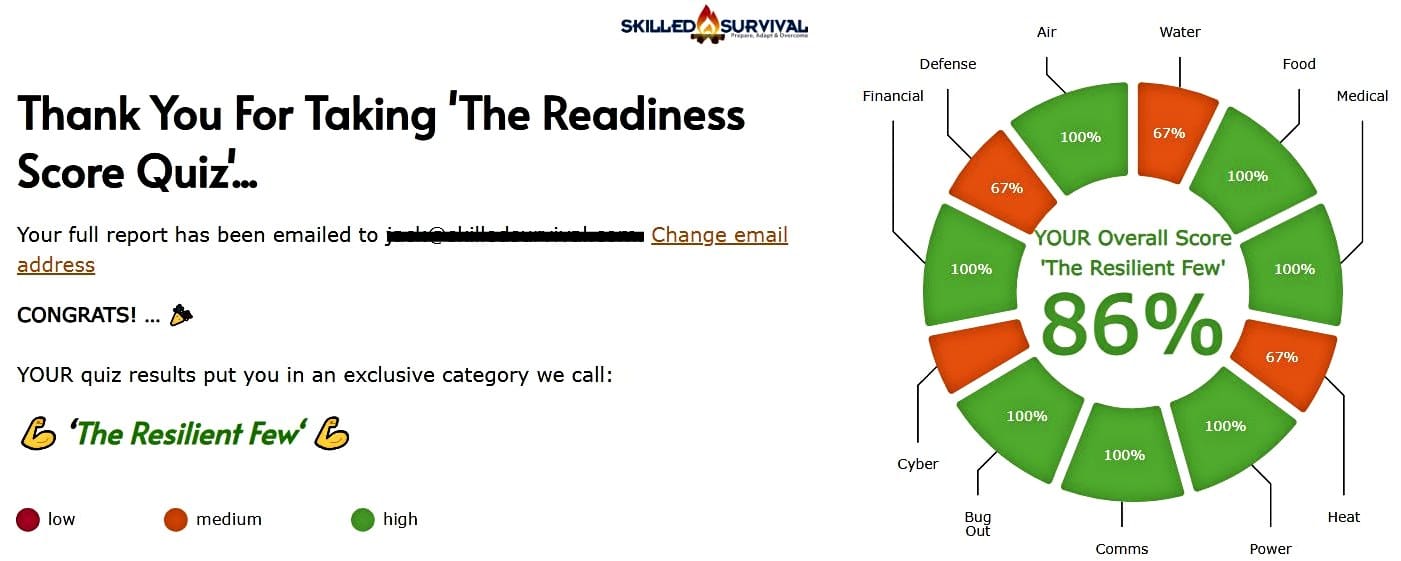
AND... I've still got a few gaps in my preps...🤔 But at least, I'm not part of 'The Fragile Masses'. 👍 Find out where YOU stand by answering a few questions...
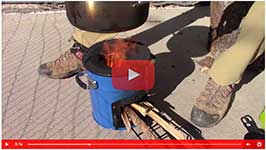
Recommended Reading
LifeStraw Review: An Expert Puts It To The Ultimate Test
LifeStraw Review - with no moving parts, chemical additions, or batteries, it provides a lightweight, compact filter to treat up to 4000L...
Best Survival Bow: 16 Surprising Reasons YOU Should Get One
A survival bow is one of the most underappreciated weapons I think EVERYONE should own. Here are 16 reasons why YOU should get one today.
Best Survival Hatchets: Tough Enough To Outlast The Wild
Not all hatchets are created equal. A quality survival hatchet can do tasks even a survival knife cannot. Here's the one I carry in my pack.
Best Survival Radios: Why You Must Secure One (before SHTF)
Be the ONE who knows what the hell is going on after SHTF. Here's how to set yourself up with a reliable survival radio in a future disaster.
Best EDC Flashlight: Simple, Small, Compact & Super Bright
The best edc flashlight is durable, bright, compact and worth carrying! In this guide, we review the best one to make your search easy.
11 Proven DIY Survival Gear Projects ANYONE Can Follow
Building DIY survival gear doesn't NEED to be complicated to be effective. Here are the 11 best projects you can finish in just a few hours.

